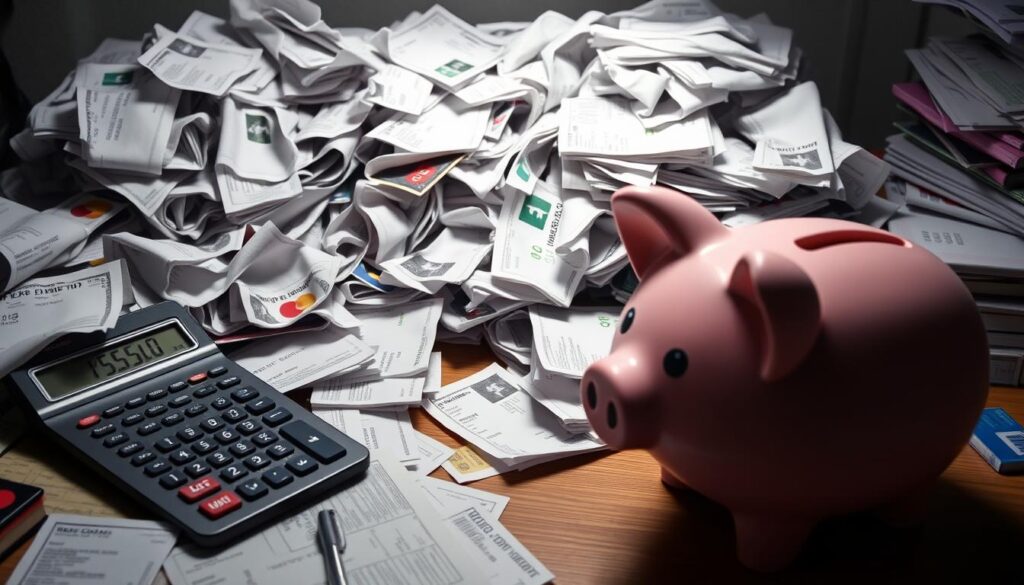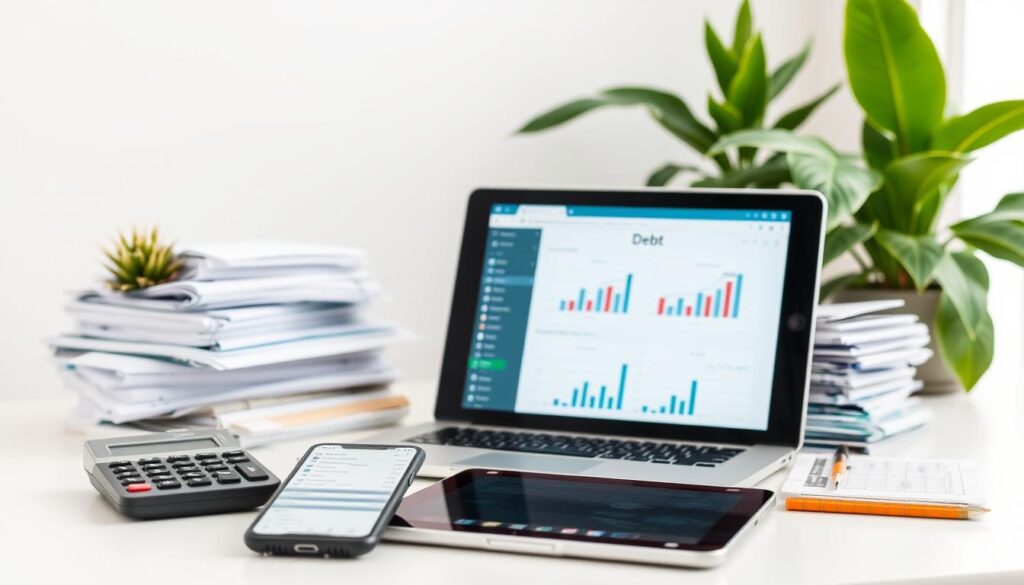Are you struggling with credit card debt? You’re not alone. Total U.S. credit card debt hit $1.14 trillion in the second quarter of 2024. The average household with credit card debt owed $21,367 in December 2023. To pay off credit card debt, you need a solid plan and a commitment to paying it back.
Credit card companies must show how paying more than the minimum can save you money on interest. This makes it important to pay more than the minimum each month.
It’s crucial to tackle credit card debt quickly to become debt-free. High APRs can quickly add up, making a solid repayment plan essential. This guide will share expert tips on paying off credit card debt fast. You’ll learn about financial planning and debt repayment strategies.
With the right strategies, you can clear your credit card debt and gain financial freedom. Credit counseling services can help by consolidating your debt at a lower interest rate. This means making one payment that’s less than the sum of your current minimum payments. Personal loans, often used for debt consolidation, usually have lower interest rates than credit card debt.
Table of Contents
Key Takeaways
- Paying more than the minimum balance can lead to paying less interest overall
- Credit card debt can be managed with a solid financial planning strategy
- Debt repayment requires a commitment to paying off credit card debt
- Credit counseling organizations can help consolidate debt at a lower interest rate
- Personal loans can have lower interest rates than credit card debt
- Financial planning and debt repayment strategies are essential for becoming debt-free
- Understanding credit card debt and its impact on financial health is crucial for making informed decisions
Understanding Your Credit Card Debt Situation

To tackle your credit card debt, it’s key to know your current situation. You need to figure out your total debt balance, the interest rates on each card, and how much you can pay each month. This knowledge helps you make a plan to pay off your debt quickly.
Managing debt means understanding how interest rates affect your monthly payments. With average credit card interest rates at 22.63%, it’s important to tackle this. Here are steps to help you manage your debt:
- Calculate your total debt balance by adding up all your credit card balances.
- Find out the interest rates on each card to focus on the highest first.
- Figure out how much you can pay each month based on your income and expenses.
Knowing your credit card debt situation helps you make smart decisions. You can plan to pay off your debt balance and reduce the effect of interest rates on your monthly payments.
Creating Your Debt Payoff Action Plan
To achieve financial freedom, you need a personalized debt payoff plan. This plan should match your financial goals and consider your credit score and debts. A good plan keeps you focused and motivated during the debt repayment journey.
When making your debt payoff plan, think about these important points:
- Find out how much debt you have and which debts have the highest interest rates
- Set clear financial goals, like paying off a certain amount of debt by a specific time
- Make a budget that puts a lot of your income towards paying off debt
- Look into ways to lower your interest rates, like talking to your credit card company or doing a balance transfer
Using a debt reduction method, like the debt avalanche or snowball method, can help you tackle high-interest credit card balances efficiently. It’s also important to build an emergency fund while you’re paying off debt. By following these steps and sticking to your plan, you can boost your credit score and achieve long-term financial success.
Creating a debt payoff plan is a key step towards financial freedom. By managing your debt and making a personalized plan, you can overcome financial hurdles and look forward to a brighter financial future.
| Debt Type | Interest Rate | Balance |
|---|---|---|
| Credit Card | 22.7% | $10,800 |
| Auto Loan | 6.5% | $20,000 |
| Student Loan | 4.5% | $30,000 |
Essential Steps to Pay Off Credit Card Debt
To pay off credit card debt, stop using your cards and save for emergencies. This prevents more debt and keeps you safe in tough times. Experian says the average U.S. person owes $6,365 on credit cards, showing the need for a good plan.
Tracking your spending is key to finding ways to save more for debt. Knowing where your money goes helps you make a budget that works. Try the 50/30/20 rule: 50% for needs, 30% for wants, and 20% for savings and debt.
- Consider consolidating your debt into a lower-interest loan or balance transfer credit card
- Make more than the minimum payment each month to pay off the principal balance faster
- Avoid new credit inquiries and applications while you’re paying off debt
| Debt Repayment Strategy | Benefits |
|---|---|
| Debt Snowball | Paying off smaller balances first can provide a psychological boost |
| Debt Avalanche | Paying off high-interest balances first can save you more money in interest |
Choosing the Right Debt Repayment Strategy
There are many ways to pay off debt. Two common methods are the avalanche and snowball methods. The avalanche method focuses on debts with the highest interest rates first. This can save money and time.
The snowball method, on the other hand, starts with the smallest balance. It helps build momentum and motivation. Both methods have their advantages.
Choosing the right method depends on your financial situation and goals. Debt repayment strategies should fit your needs. For example, the avalanche method is good for high-interest debt. The snowball method is great for quick results.
Success in debt repayment comes from finding a strategy that works and sticking to it. Understanding the debt repayment strategies, like the avalanche method and snowball method, helps make informed choices. The goal is to become debt-free and achieve financial stability.
Boosting Your Income for Faster Debt Payment
To reach financial freedom, boosting your income is key. This money can go straight to debt payment. It’s a fast way to become debt-free. You can earn more by getting a side job, selling things you don’t need, or learning new skills.
More income means you can pay off debt faster. With more money, you can put more towards debt payment. This way, you’ll get to financial freedom sooner. Here are some ways to make more money:
- Sell unwanted items through online marketplaces or local consignment shops
- Take on freelance work or a part-time job to earn extra cash
- Negotiate a salary increase with your current employer
Using these strategies can lead to more income. This extra money can help pay off your debts quickly. Remember, always focus on debt payment and make smart money choices for a secure future.
| Strategy | Potential Income Increase |
|---|---|
| Selling unwanted items | $500-$1000 per month |
| Freelance work or part-time job | $1000-$2000 per month |
| Salary negotiation | 5-10% increase in annual salary |
Negotiating with Credit Card Companies
Dealing with credit card debt means knowing credit card companies can help. They might offer repayment plans or lower interest rates. To get their help, you need to know what they can do and how to ask for it.
Some key options to consider when negotiating with credit card companies include:
- Requesting lower interest rates to reduce the amount of interest accrued on your debt
- Exploring hardship programs that may offer temporary relief from payments or reduced interest rates
- Debt settlement options, which can help you pay off your debt in a lump sum or through a payment plan
Credit card companies might agree to settle for a part of what you owe, usually between 10% to 50%. But, this can hurt your credit score. It will show up as “settled” instead of “paid in full”.
Before you start talking to credit card companies, understand how it might affect your credit score. Look into other options like debt consolidation or refinancing. Being well-informed and ready can help you negotiate better and find a solution that suits you.
Smart Budgeting Techniques for Debt Reduction
Effective budgeting techniques are key to reducing debt. By making a budget that focuses on paying off debt, you can make big strides. It’s important to track your spending and group your expenses to find ways to cut back.
Start with the 50/30/20 budgeting method. This means 50% of your income goes to needs, 30% to wants, and 20% to savings. This helps you put more money towards debt reduction. Also, saving three to six months’ worth of expenses in an emergency fund can help avoid new debt.
Here are some useful tips for budgeting techniques:
- Don’t use credit cards for new things
- Make a budget every month to focus on debt reduction
- Think about debt consolidation if it saves you money with a lower interest rate
By using these budgeting techniques and keeping your finances in check, you can steadily reduce your debt. This leads to long-term financial stability.
Balance Transfer Cards: Pros and Cons
Balance transfer cards can help you pay off credit card debt. They let you move your balance to a new card with a lower interest rate. This can save you money on interest. These cards often have a 0% APR for 12 to 21 months.
But, it’s important to know the good and bad sides of balance transfer cards. They can make managing your debt easier by lowering interest rates. Some cards also offer rewards or bonuses, which can be great if you use them wisely.
How Balance Transfers Work
Transferring your balance means moving it to a new card with a lower rate. You apply for a new card that allows balance transfers. Once approved, you move your balance, saving on interest. Remember, balance transfer fees are 3% to 5% of the amount moved.
Selecting the Best Balance Transfer Card
To find the best card, look at a few key things:
- Introductory APR and how long it lasts
- Balance transfer fee
- Regular APR after the intro period
- Annual fee
- Rewards or sign-up bonuses
Look for cards with 0% APR for 12 to 21 months and fees from 3% to 5%. Always check the terms and the APR after the intro period.
Common Balance Transfer Pitfalls
Balance transfer cards can be helpful, but there are risks. These include:
- High balance transfer fees
- APRs that go up after the intro period
- Accumulating more debt if not managed well
Knowing the pros and cons and choosing the right card can help. Always read the fine print and consider interest rates, fees, and rewards.
| Balance Transfer Card | Introductory APR | Balance Transfer Fee | Regular APR |
|---|---|---|---|
| Card A | 0% for 12 months | 3% of transferred amount | 18.99% – 27.99% |
| Card B | 0% for 21 months | 5% of transferred amount | 19.99% – 28.99% |
Debt Consolidation Options Worth Considering
Dealing with many credit card debts can be tough. Debt consolidation might help by making payments easier and possibly lowering interest rates. It involves getting a new loan to pay off old debts, which can boost your credit score over time. It’s key to look at different loan options and pick the one that fits your financial needs.
Popular choices include balance transfer credit cards, personal loans, and home equity loans. Each has its own benefits and drawbacks, like interest rates, fees, and how long you’ll pay it back. For example, balance transfer cards might charge a 3% to 5% fee for moving your balance, while home equity loans usually have lower rates than personal loans.

- Interest rates and fees associated with each loan option
- Repayment terms, including the loan duration and monthly payment amount
- Impact on your credit score, both positive and negative
- Any potential risks or penalties, such as prepayment penalties or origination fees
By carefully looking at these points and picking the best debt consolidation option, you can make payments easier. This can help improve your financial health. Always check the terms and conditions of any loan or credit product before deciding. And don’t hesitate to get advice from a financial expert if you need it.
Building Better Financial Habits
Good financial habits are key to long-term financial stability. Creating a sustainable budget helps manage income and expenses well. By focusing on needs over wants, you can save and pay off debt effectively. Financial habits like these are crucial for managing debt and building wealth.
Setting up saving routines is also important. Saving a part of your income regularly builds an emergency fund. This fund helps cover unexpected costs without debt. Saving for goals like retirement or a big purchase boosts motivation to keep good financial habits. Budgeting helps you see where your money goes and make smart choices.
To avoid debt traps, understand your spending feelings and make smart choices. Being aware of your financial habits and making changes helps you have a healthier money relationship. This way, you can reach your long-term financial goals.
Common Mistakes to Avoid While Paying Off Debt
When you’re trying to pay off debt, it’s key to avoid common mistakes. One big debt repayment mistake is using one credit card to pay off another. This can dig you deeper into debt and hurt your credit score.
To avoid financial pitfalls, you need to know your credit card terms. Don’t just make the minimum payment on high-interest cards. This can take 5 to 10 years or more to clear your balance, costing you a lot in interest.
Here are some common mistakes to avoid:
- Using one credit card to pay off another
- Making only minimum payments
- Not understanding the terms and conditions of your credit card agreements
By steering clear of these mistakes and making a solid plan, you can boost your credit score and gain financial freedom. Always focus on paying off high-interest debt first. Try to pay more than the minimum to cut down your debt fast.
| Mistake | Consequence |
|---|---|
| Using one credit card to pay off another | Deeper debt and negative impact on credit score |
| Making only minimum payments | Longer payoff period and more interest paid |
| Not understanding credit card agreements | Hidden fees and unexpected changes in interest rates |
Using Technology to Manage Debt Repayment
Managing debt can be easier with technology. Tools like debt management apps help track money coming in and going out. This makes it simpler to keep up with debt payments. For example, debt tracking apps like Debt Payoff Planner and Qapital let you see how you’re doing and give advice tailored to you.
Some top tools for managing debt include:
- Debt Payoff Planner app, rated 4.7 on the App Store and 4.5 on Google Play
- Qapital app, with ratings of 4.8 on the App Store and 4.4 on Google Play
- Bright Money app, rated 4.8 on the App Store and 4.7 on Google Play
When picking debt management tools, look for things like strong encryption and easy account linking. Also, check what others say about them. Using financial tech and budgeting apps can make paying off debt faster and easier.

| App Name | Rating (App Store) | Rating (Google Play) |
|---|---|---|
| Debt Payoff Planner | 4.7 | 4.5 |
| Qapital | 4.8 | 4.4 |
| Bright Money | 4.8 | 4.7 |
Maintaining Motivation During Debt Repayment
Staying motivated while paying off debt is key to reaching financial goals. Seeing progress, like paying off smaller debts first, boosts motivation. Celebrating small wins keeps debt repayment motivation alive.
Here are some ways to stay motivated:
- Break down big debt amounts into smaller pieces
- Track progress visually towards your financial goals
- Set small rewards for reaching milestones in debt repayment
- Surround yourself with people who support you
Reading success stories of those who beat debt can motivate you too. Also, joining podcasts and online forums about personal finance and debt can help keep you motivated.
By using these strategies and staying positive, you can beat debt fatigue. This will help you stay on track to meet your financial goals.
| Debt Repayment Method | Benefits |
|---|---|
| Debt Snowball | Quickly eliminates smaller debts, providing motivation |
| Debt Avalanche | Saves money on interest, reducing overall debt |
When to Seek Professional Financial Help
Managing debt can feel overwhelming. Sometimes, you need professional help. If you’re struggling to pay off debts or feeling stressed, it’s time to seek help.
Credit Counseling Services
Credit counseling services offer a personalized plan to manage your debt. They are often non-profit. They can help you negotiate with creditors to reduce interest rates or fees.
Financial Advisor Consultation
A financial advisor can help you create a comprehensive financial plan. This includes debt management, budgeting, and investment strategies. Look for a fee-only advisor with certifications like Certified Financial Planner (CFP).
Bankruptcy Warning Signs
If you’re experiencing persistent financial stress, missing payments, or accumulating high-interest debt, it may be a sign that you need to consider bankruptcy. However, this should be a last resort. Explore other options first, such as debt consolidation or credit counseling.
Remember, seeking professional financial help is a sign of strength, not weakness. By taking control of your finances and seeking help when needed, you can achieve financial stability and peace of mind.
Conclusion: Your Path to Financial Freedom
Starting your journey to pay off credit card debt means you’re taking charge of your financial future. By following the strategies in this guide, you can overcome your debt and avoid high-interest credit card balances. Stay focused, celebrate your wins, and look forward to a future where you can build wealth and achieve your dreams.
Consistent budgeting, smart spending, and strategic planning will help you. Embrace the journey, seek help when you need it, and know that every step brings you closer to financial freedom. You can do it – your path to financial freedom is within reach.
FAQ
What are the consequences of high APRs on credit card debt?
High APRs on credit cards can cause big interest charges. This makes it harder to pay off the balance. It also leads to a bigger debt over time.
How can I calculate my total credit card debt balance?
To find your total credit card debt, add up the balances on all your cards.
What are the benefits of a well-planned debt repayment strategy?
A good debt repayment plan can make you debt-free faster. It also cuts down on interest paid. This improves your financial health and stability.
Why is it important to stop using credit cards during the debt repayment process?
Not using credit cards while paying off debt is key. It stops new debt from building up. This lets you focus on clearing your current balances.
What are the key differences between the avalanche and snowball debt repayment methods?
The avalanche method targets the highest-interest debt first. The snowball method focuses on the smallest balances first. Choose based on your financial situation and goals.
How can increasing my income help me pay off credit card debt faster?
Getting more income through a side job or selling items can help. It gives you more money to put towards your debt. This speeds up your journey to financial freedom.
What are some effective strategies for negotiating with credit card companies?
To negotiate with credit card companies, ask for lower interest rates. Understand hardship programs and debt settlement options. These can help reduce your debt.
How can using a balance transfer card benefit my debt repayment efforts?
Balance transfer cards can save you on interest and speed up debt repayment. But, know the terms and potential risks first.
What are the key considerations when exploring debt consolidation options?
When looking at debt consolidation, think about how it affects your credit score. Also, consider the loan terms. Make sure it saves you money and helps you pay off debt faster.
What are some common mistakes to avoid during the debt repayment process?
Avoid using one card to pay off another. Don’t ignore your credit score. And, make sure your budget prioritizes debt repayment.
When might it be necessary to seek professional financial help for credit card debt?
You might need professional help if managing debt is tough. Or if you need advice on debt settlement or bankruptcy.







